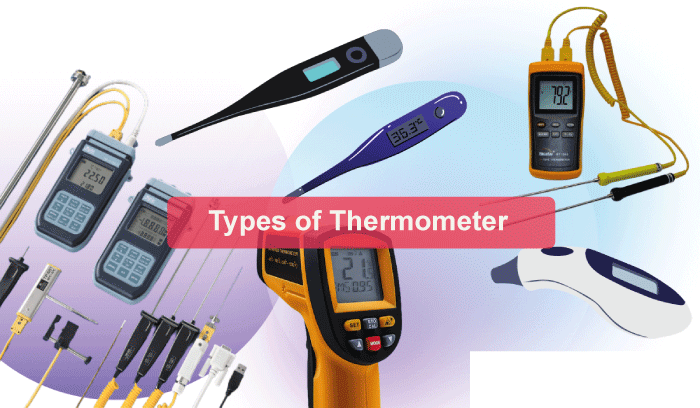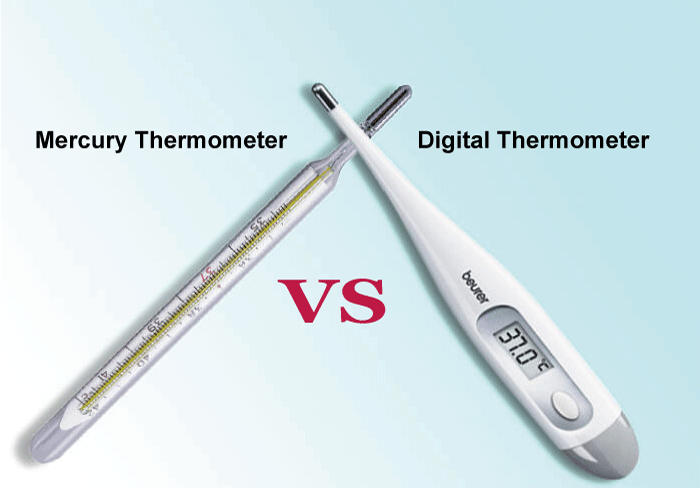Thermometer DefinitionOverview:Instruments that measure temperature are called thermometers. A thermometer is a device used to measure temperature. The thermometer is typically a sealed glass tube containing a column of liquid, such as mercury that expands and contracts or rises and falls in response to temperature changes. The temperature is read where the top of the column coincides with a calibrated scale marked on the tube or its frame. They are utilized in various applications and are available in various forms, sizes, and patterns. The mercury thermometer is the most popular kind of thermometer. It comprises a glass tube with a bulb at the bottom and a tiny mercury column inside. The mercury expands when heated, raising the tube and displaying the temperature. Mercury-based thermometers are a common option for daily use since they are precise, dependable, and simple to use. The digital thermometer is yet another sort of thermometer. It detects temperature like a mercury thermometer, but instead of mercury, it indicates temperature using electrical signals. Digital thermometers are frequently utilized in scientific and medical applications because they are substantially more accurate than mercury thermometers. Additionally, they cost a lot less than mercury thermometers. Infrared thermometers are the last type, which gauges the surface temperature using infrared light. Infrared thermometers are frequently employed in industrial settings to monitor body temperature or in the medical field to evaluate the temperature of a heated surface. Although they cost more, they are more accurate than mercury and digital thermometers. In summary, many different thermometers are available, each with unique benefits and drawbacks. One type may be better suited for a given purpose than another. Making the best decision requires a basic understanding of thermometers. How Thermometers Measure Temperature and Operate:The thermometer is one of the earliest and most popular tools for monitoring temperature. It is a straightforward technology that uses a substance whose physical characteristics vary with temperature. The thermometer employs a chemical known as a thermometric substance to gauge the temperature of anything it is put on or next to. Thermometers detect the change in the thermometric material to determine temperature. This shift typically takes the form of a physical alteration, such as a material's expansion or contraction. The thermometer detects this change, which then transforms it into a temperature reading. The liquid-in-glass thermometer is the most popular kind of thermometer. A bulb filled with a liquid?typically alcohol or mercury?and a long, thin glass tube make up this sort of thermometer. The liquid in the tube expands or contracts as the temperature varies, and the variation in the liquid level determines the temperature. A thermistor, a device that alters its electrical resistance in response to temperature, is used in an additional type of thermometer, the electronic thermometer. The thermistor is a circuit component that transforms the change in resistance into a temperature measurement. Thermometers get increasingly precise and accurate as technology develops. The basic principles behind thermometer operation have not changed, nevertheless. The thermometer measures the temperature by detecting the change in a thermometric material. Common Uses for Thermometers:Thermometers are a useful instrument for measuring temperature in a range of circumstances. They are frequently employed in several industries, including engineering, food processing, and healthcare. Thermometers are frequently used to measure body temperature in the medical industry. These thermometers, which can be digital or analog, are made to measure the body's temperature precisely. Compared to analog thermometers, digital thermometers often deliver more accurate and exact readings. The temperature of food products is also measured using thermometers during food processing. Because some foods might become unhealthy if not prepared or stored at the right temperature, this is crucial for guaranteeing food safety. The temperature of various components is measured in engineering using thermometers. This is crucial to prevent overheating and component breakdown. The automotive sector and meteorology are also the fields in which thermometers are used. The temperature of the atmosphere is measured in meteorology using thermometers. Thermometers measure the automotive industry's temperature of engines and other components. Thermometers are a crucial piece of equipment for monitoring temperature in any situation. They can be used in several contexts to measure temperature precisely and are available in various sizes and designs. Different Ways to Use Thermometers:Thermometers are our go-to source for precise temperature data. But there are lots of applications for them. Clinical thermometers are primarily used in clinics and hospitals to assess body temperatures. They are also used in households to check a sick person's body temperature. They typically consist of glass and feature a mercury-filled bulb at one end. The mercury expands and rises in the tube as the body temperature rises. The most popular form of thermometer used today is a digital one. They are made to take temperature readings rapidly and precisely. They frequently have a digital display and are composed of plastic. They are simple to use and can gauge the temperature of liquids, the air, and the human body. A growing number of people are using infrared thermometers. They do this by detecting the infrared light that an object emits. They are frequently employed in science and industry to gauge the temperature of hot surfaces like furnaces and motors. In harsh conditions, thermocouples are employed to measure temperature. They are constructed from two wires of various metals linked at one end. A meter can be used to measure how the electrical resistance of the wires varies as a result of temperature variations. Small thermometers are instruments used to gauge temperature. They typically have two wires attached to them and are constructed of ceramic. The thermistor's resistance changes due to temperature variations, and this change can be measured using a meter. Temperature variations across a variety of temperatures are measured using bimetallic strips. They are made of two metals that change in size and shape differently due to heat and cold. The resulting bend in the strip can be measured using a meter. A wide variety of temperatures can be measured with thermographs. They are composed of a thermocouple attached to a recorder, creating a graph of the temperature variations. Using this, tracking and examining temperature variations over time are possible. These are only a few applications for thermometers. They are crucial equipment for many industries and can take precise temperature readings. Pros and Cons of Different Thermometer Types:Measurement of temperature is crucial to both medical care and research. There are numerous varieties of thermometers available, each with unique benefits and drawbacks. 
To assist you in selecting the thermometer that best suits your needs, we will examine the benefits and drawbacks of the four primary thermometer categories.
The Benefits of Using a Digital Thermometer over a Traditional Thermometer:Traditional thermometers can be effectively replaced with digital thermometers. Due to their many benefits, they are growing in popularity. Digital thermometers can take temperatures quickly and conveniently and are more accurate than traditional thermometers. Accuracy is one of the main benefits of digital thermometers. 
Traditional thermometers do not measure temperatures as accurately as digital thermometers can. When taking a baby's or small child's temperature, this is very crucial. Digital thermometers may be used repeatedly without needing to be calibrated and do not require shaking down to achieve an accurate reading. Additionally, digital thermometers are substantially quicker than analog thermometers. This is extremely useful when taking temperatures from newborns and young children, who can get upset and uncomfortable if a thermometer takes too long. Digital thermometers can be applied to various surfaces, including the ear, mouth, and forehead. Because of this, they are more practical and adaptable than conventional thermometers. Additionally, digital thermometers are significantly simpler to use than analog thermometers. They take very little setup and come with simple instructions. Digital thermometers with pre-set temperature ranges pre-programmed are also available, so you do not have to modify the settings manually. Overall, digital thermometers have a lot of benefits over analog ones. They are simpler to operate, faster, and more accurate. They have pre-programmed temperature ranges and can be used in numerous locations. Traditional thermometers can be replaced with digital thermometers, which can take temperatures easily and rapidly. How to Correctly Use a Thermometer:A thermometer must be used correctly to produce an accurate reading. Here are some pointers on how to correctly use a thermometer:
You can ensure that you are using your thermometer correctly and getting an accurate reading. Tips for Using Thermometers Safely:When using thermometers, it is necessary to use caution because they sometimes contain dangerous components. Consider the following safety advice when using thermometers:
You can ensure that your thermometer is used safely and correctly by adhering to these safety recommendations. Factors that Impact Thermometer Accuracy:Accuracy in taking temperatures is essential. You can obtain the most accurate findings by knowing the variables that may impact thermometer accuracy. The sort of thermometer being used should be considered first. Because they depend on the operator to accurately read and understand the scale, analog thermometers are less accurate than digital thermometers. On the other side, digital thermometers offer a highly accurate digital readout. The placement of the thermometer is another critical element. It can give false readings if not positioned properly in the body. For instance, the lips should be tightly closed while taking an oral temperature, and the thermometer should be positioned beneath the tongue. The environment may also impact the accuracy of thermometers. Both quick temperature changes and high humidity levels impact the reading. The thermometer's age can also be an issue. To ensure that they are providing accurate readings, thermometers should undergo routine calibration. It is recommended to calibrate following the manufacturer's recommendations. You can ensure you get the most accurate readings by being aware of the variables that can affect thermometer accuracy. Conclusion:Thermometers are necessary equipment for determining a variety of things' temperatures. They can determine its temperature by sensing the thermal energy that a substance emits. Although many thermometers exist, digital and analog thermometers are the most used. Analog thermometers use a liquid-filled tube to detect temperature, while digital thermometers use sensors. Both thermometers can measure the temperature of a wide range of things, including people, animals, and water. When choosing a thermometer for use, one should also consider its accuracy, precision, and type. Although digital thermometers are typically much more expensive than analog thermometers, they are typically more accurate and precise. To ensure accuracy and precision, it is crucial to calibrate thermometers regularly. When calibrating a thermometer, temperature readings are taken at various temperatures to determine whether the thermometer needs to be adjusted. You can ensure you are using the most precise and accurate thermometer for any given application by studying more about it.
Next TopicWhat is Tense Definition
|
 For Videos Join Our Youtube Channel: Join Now
For Videos Join Our Youtube Channel: Join Now
Feedback
- Send your Feedback to [email protected]
Help Others, Please Share









